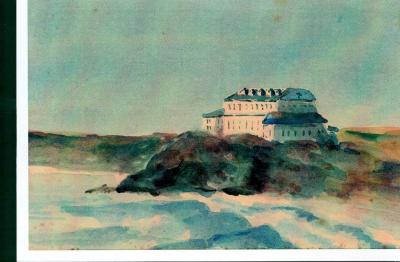Murder in Montara: The Babes in the Woods Case 1946; Part V
There was a lot of back-and-forth over where Vorhes Newtonâs arraignment would take place in the summer of 1946. Who knows how they finally worked it out but those officials who pushed the Redwood City County Courthouse venue, lost, and it was decided the 24-year-old Newton would be arraigned on the Coastside where his horrific crime had been committed.
Half Moon Bay was a rural country village, and Judge Manuel Bettencourt, who presided over the court there, was the kind of man you either liked or hated, He was called âThe Judgeâ? and depending on who was saying it, âThe Judgeâ? sounded warm and friendly or tainted with a smoldering ire.
One thing nobody could deny, âThe Judgeâ? had broken social barriers by marrying the pert, outgoing Irene Debenedetti, the daughter of one of the most prominent families in town. She was Italian; he was Portuguese; theirs may have been the first such important marital union in Spanishtown, as the ârealâ? locals called Half Moon Bay.
It was only an arraignment, a legal procedure measured in minutes, but no matter how small his role âthe Judgeâ? would be a presence.
Judge Bettencourtâs office/courtroom stood on Main Street, across the way from today’s âOriginal Johnnyâsâ? coffee shop. Bettencourtâs courtroom was a space big enough to hold a maximum of 25 spectators.
Dubbed the âBabes in the Woodsâ? case by the press, Vorhes Newton had attracted national attention putting Redwood City, where the heavy legal business was conducted, on the map. This case could make reputations.
Due to all the attention, Judge Bettencourtâs Half Moon Bay courtroom couldn’t comfortably accommodate all the photographers, reporters, the curious, the locals and the participants. Sheriffâs deputies, with their prisoner, had to push through the crowd before a decision was made to move the whole show to the nearby high schoolâs gymnasium, accommodating 150 spectators. When the bleachers were full, chairs were quickly brought in and a courtroom improvised with tables from the classrooms.
Sheriff Walter Moore, member of a prominent Pescadero family, acted as bailiff. County District Attorney Gilbert Ferrell arrived with Fred Wyckoff, Ferrellâs second-in-command who had done most of the early case work.
The noise of onlookers didnât drown out official voices in the makeshift courtroom in the school gym– rather there was a stunned quiet– and, besides the normal curiosity associated with people wanting to see the kind of man who would murder his own children–there was pity for young Vorhes Newton.
Wearing a checkered sports jacket and brown tie, Vorhes had a scrubby brown beard, his face was bruised, his black eye colored a purplish hue now. His own personal trial had caused his shoulders to droop. When his eyes searched the school gym, he recognized half a dozen members of his family but Vorhes didn’t smile or nod at them. He still couldn’t believe he committed the murders.
Judge Bettencourt asked the defendant if Vorhes Newton was his name and he softly answered, âYesâ?.
Then followed a series of damning witnesses First was Fred Simmons, Half Moon Bayâs deputy sheriff. He spoke of bringing a bloodied Lorraine Newton to the Community Hospital. He told of finding the bodies of the two little ones.
John Kyne testified to finding the bodies of the two babies at the Montara flower ranch which was also confirmed by Kyneâs employees James Fiedler and Steve Torre,.
Mrs. Dodd, the Newtonâs Alameda neighbor, told the court that she accompanied the Newton family on the first part of the murder ride. She was dropped off at the Alameda navy base. Later that day she saw Vorhes return home alone.
Of interest to defense attorney Leo Friedman was Mrs. Doddâs statement that she often heard Vorhes call his wife, âBossâ?. In her opinion Lorraine Newton was the quarrelsome type, not her husband.
Witness Anthelmo Quaves said he saw an auto containing a man and woman drive slowly into the lonely canyon and heard yelling and the sounds of someone being beaten. He said he saw the auto come back speeding out of the canyon.
Lorraineâs mother, Mrs.Tuttle, said her daughter was improving and identified her engagement and wedding rings
Defense attorney Leo Friedman revealed that Mrs. Newton knew she was pregnant, wanted to confirm it with a doctor and left open an abortion.
Newton sat solemnly at a studentâs desk in the makeshift courtroom, obviously relieved when Deputy Sheriff Jack OâBrien escorted from out of the courtroom and back to the car that would return him to the Redwood City County Jail.
Outside the courtroom in Half Moon Bay, defense attorney Leo Friedman joked with reporters and photographers. They knew him from for his role in two sensational trials, that of Mrs. Frances Andrews and David Lamson.
Lorraine Newton did not make an appearance. So far she had remained in the background.
To be continued….

